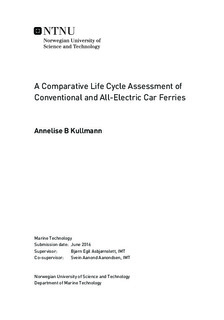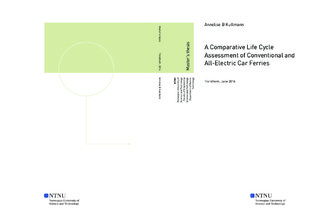| dc.description.abstract | Abstract
Increased environmental focus in the marine transport sector, and especially focus on its effect on global warming, have initiated the deployment of all-electric propulsion. This thesis quantifies the environmental impacts of four ferry alternatives using the method of life cycle assessment (LCA). An all-electric lightweight catamaran in aluminium is compared to a conventional diesel powered monohull in steel. In addition, two theoretical cases are included where the design is the same as the all-electric ferry but the energy carrier is liquefied natural gas (LNG) or marine diesel oil (MDO).
The objective of this thesis is to acquire insights to environmental savings and burdens associated with all-electric ferries and to identify where the largest improvements are possible. This is analysed by performing a comparative LCA on the four cases mentioned. Current studies within the field are somewhat incomplete, and it is therefore strived to establish a transparent dataset to improve the basis for future studies. In Norway the domestic car ferry fleet is also aging and many of them will be replaced when new tender demands are set.
A specific ferry route and two ferry designs were chosen as the basis for the analysis. MS Ampere, the world s first all-electric car ferry operating a ferry route across the Sognefjord in Western Norway, were one of the designs used. MF Oppedal is operating the same ferry route and were the second design used in the analysis.
In the study the impacts are calculated using the ReCiPe characterization method. The impacts are grouped in 18 different categories, linked to different environmental problems or public concerns, called mid-point indicators. Three perspectives are used: egalitarian, hierarchist and individualist. The egalitarian represents a long term, careful and argument-based view. Individualists are looking at short-term and require indisputable cause and effect relations in order to take actions. Hierarchists are somewhere in between, being risk neutral and looking at an intermediate time horizon.
Results in three impact categories global warming potential, human toxicity and terrestrial acidification are presented for the hierarchist viewpoint. This is a selection of three impact categories to illustrate the methodology. The educational software Arda Gui, version 1.8.1 have been used in the impact calculations. Impacts are divided on in the processes battery/engine, hull and operation. The all-electric ferry is run on the average Norwegian electricity supply mix modelled in the Ecoinvent 2,2 database.
The full set of results also have impact categories concerning land use, resource depletion, different toxicity impacts, eutrophication, radiation, ozone depletion, particulate matter formation and photochemical oxidant formation. Different units for a typical pollutant or attribute relevant to the environmental issue or public concern are the quantification method.
The all-electric ferry outperforms the conventional alternatives in impact categories linked to combustive stressors and fossil fuels. Such impact categories are climate change, photochemical oxidant formation, ozone depletion, particulate matter formation and fossil fuel depletion. The all-electric and LNG ferry are significantly better than the ferries run on MDO when considering terrestrial acidification. This is due to the fact that there is no sulphur in the fuel. The electrical ferry has larger impact in all categories concerning toxicity except for the terrestrial ecotoxicity.
A sensitivity analysis of important parameters were performed to investigate the dependency between input and results. Electricity mix, metal used for hull and engines, the number of trips per lifetime and battery life were the parameters varied. The results prove to be sensitive to the electricity mix used. In addition the metal used for hull and engines had impact for the category metal depletion.
The analysis identifies that using all-electric ferries gives a problem shift with reducing impacts in categories linked to combustive stressors and fossil fuels and increasing impacts in toxicity. Similar tendencies have been presented in studies on electrical cars. Extraction of copper as input to the electricity grid and battery contribute largely in the toxicity categories. This makes the results highly dependent on the modelling of background processes such as electricity. The researcher has had limited access to database descriptions of such processes, and the choice of processes can therefore be a source of inaccuracy. Further work should include more emission reducing technologies as well as more complete parts of the ferries, beeing their components, production, operation and end of life. | |

